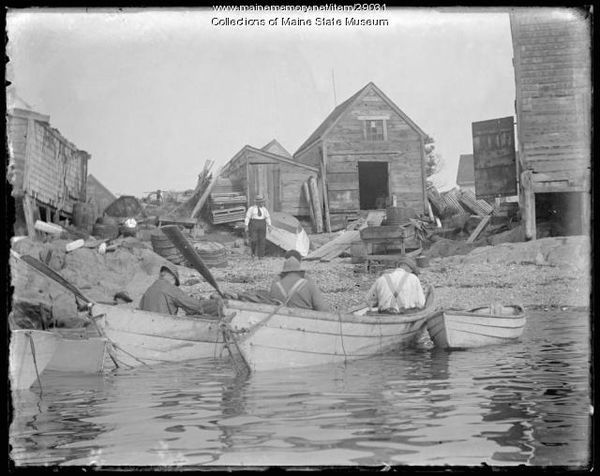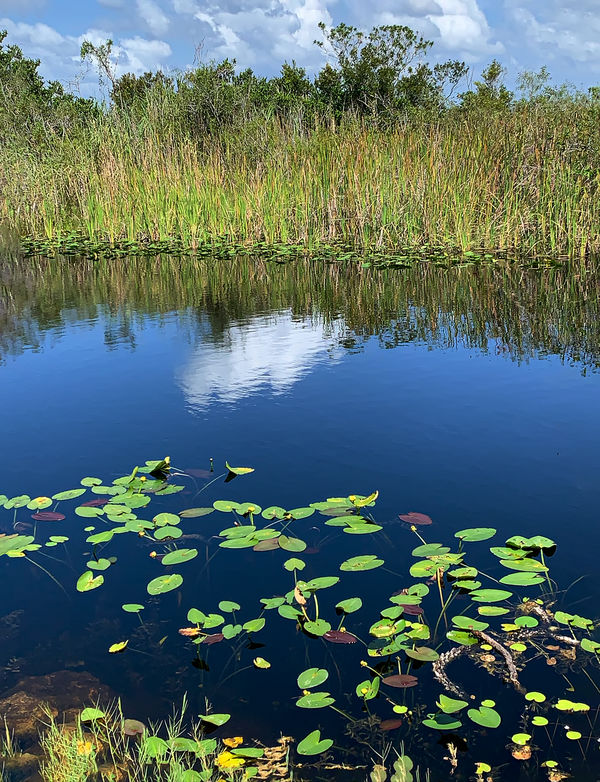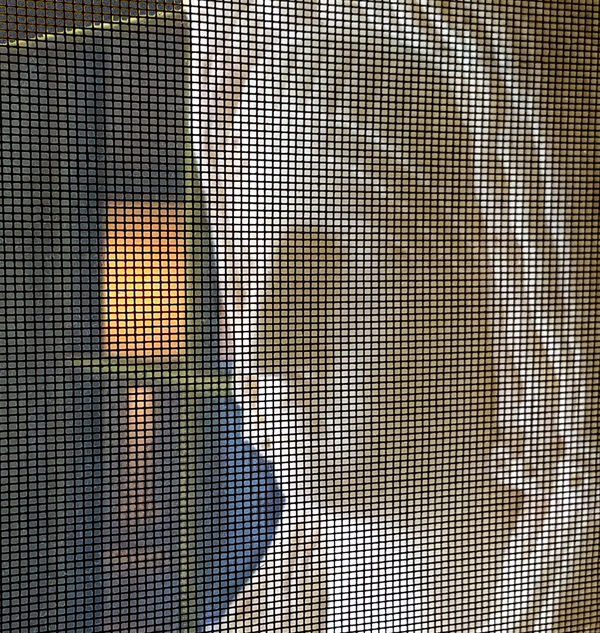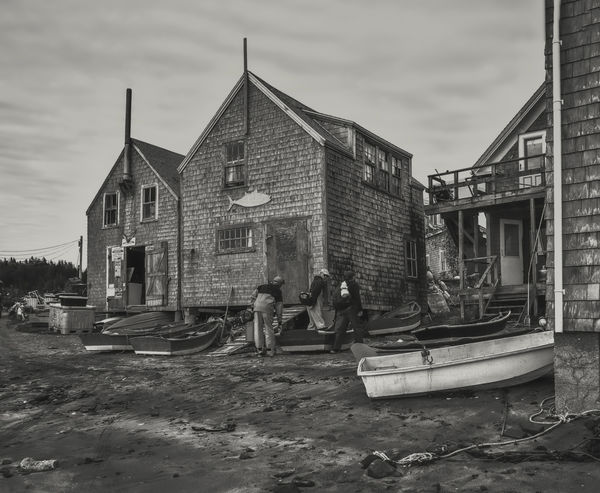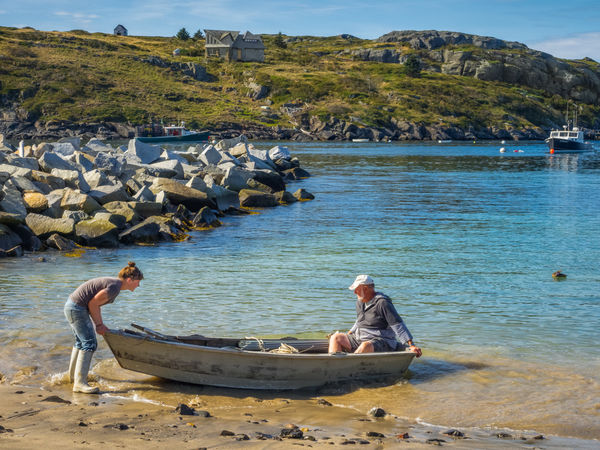Monthly Masters' Critique - October 2019 -Travel Photography As Art? - Eric Hudson's Monhegan Collection
Oct 2, 2019 10:00:01 #
Introduction
I offer this unusual Masters from the island of Monhegan, off the coast of Maine, where my husband and I are spending the week with two other photography couples/forum friends. We will, while here, attempt to capture the spirit and character of this particular place. This is essentially what many of us do when we travel afar. We will this month consider a photograph taken here in the 1800s by a traveler - its value as history, as culture, as art. And at the same time, let us consider our own travel photographs and their potential value.
Eric Hudson arrived on Monhegan Island in 1897 for two reasons. He loved to sail and he loved to paint. When he dropped anchor in the harbor of the island off the coast of Maine, he knew he had found a jewel in the ocean. He bought a house there and became part of the summer colony of artists who made Monhegan one of the most famous painting spots at the turn of the century. Hudson had another talent, too - photography. His photographs went undiscovered until 1992. Researchers compiled the collection into a book, “An Eye for the Coast”, over half of which is devoted to scenes on Monhegan Island at the turn of the century. The photos invite a reverie about the way life used to be way out there on a mile-long island in the fierce waters of the Atlantic.
As you consider the photograph posted here, share your thoughts about it, and about the photographs you document your travels with. There are some links below to learn more about Hudson’s art and photography, and some links about travel and documentary photography. Here’s some questions to spur your thinking.
Questions to Consider
1. The island is changed since 1897, of course. Most of the houses now have electricity, and most of the boats have motors. Still, there is an aura of the place that seems unchanged. How do historical photographs help us understand places and events that happened before our time?
2. What are your thoughts of the composition in this image? The subject matter? Does it tell a story? Within the constraints of its time, is it technically sound?
3. Do historical photos have a place in the world of art? Discuss your thoughts. Would you display a historical photo like this one on your wall? Why or why not?
4. Thinking forward to your own work or that of photographers you follow or admire, what is the role of the travel photograph? Do you display yours? Do you invest in printing and framing for them? Do you consider any of them art?
5. There is some current thought that in order to capture the essence of a place, one must visit it often, spend time to develop an intimate understanding, before capturing meaningful photographs. Do you agree with that? Explain.
6. Would you share a travel image you are pleased with? Give us a little of the backstory, and tell us why it has value for you.
Links for Further Study
https://vitabrevis.americanancestors.org/2018/03/monhegan-puzzle-pieces/
http://web.colby.edu/allen-island/2016/09/22/eric-hudson-and-his-landscape-photos/
https://archive.bangordailynews.com/1998/11/14/photographer-has-eye-for-the-coast-collection-of-glass-negatives-featuring-monhegan-images-evolves-into-book/
https://www.mainememory.net/artifact/29031
https://www.outdoorphotographer.com/tips-techniques/travel-photography/the-art-of-travel-photography/
http://artdaily.com/news/48710/Photographers-Examine-the-Fine-Line-Between-Documentary-and-Fine-Art-Photography#.XYgqh-dKgUw
https://www.theartstory.org/movement/documentary-photography/
I offer this unusual Masters from the island of Monhegan, off the coast of Maine, where my husband and I are spending the week with two other photography couples/forum friends. We will, while here, attempt to capture the spirit and character of this particular place. This is essentially what many of us do when we travel afar. We will this month consider a photograph taken here in the 1800s by a traveler - its value as history, as culture, as art. And at the same time, let us consider our own travel photographs and their potential value.
Eric Hudson arrived on Monhegan Island in 1897 for two reasons. He loved to sail and he loved to paint. When he dropped anchor in the harbor of the island off the coast of Maine, he knew he had found a jewel in the ocean. He bought a house there and became part of the summer colony of artists who made Monhegan one of the most famous painting spots at the turn of the century. Hudson had another talent, too - photography. His photographs went undiscovered until 1992. Researchers compiled the collection into a book, “An Eye for the Coast”, over half of which is devoted to scenes on Monhegan Island at the turn of the century. The photos invite a reverie about the way life used to be way out there on a mile-long island in the fierce waters of the Atlantic.
As you consider the photograph posted here, share your thoughts about it, and about the photographs you document your travels with. There are some links below to learn more about Hudson’s art and photography, and some links about travel and documentary photography. Here’s some questions to spur your thinking.
Questions to Consider
1. The island is changed since 1897, of course. Most of the houses now have electricity, and most of the boats have motors. Still, there is an aura of the place that seems unchanged. How do historical photographs help us understand places and events that happened before our time?
2. What are your thoughts of the composition in this image? The subject matter? Does it tell a story? Within the constraints of its time, is it technically sound?
3. Do historical photos have a place in the world of art? Discuss your thoughts. Would you display a historical photo like this one on your wall? Why or why not?
4. Thinking forward to your own work or that of photographers you follow or admire, what is the role of the travel photograph? Do you display yours? Do you invest in printing and framing for them? Do you consider any of them art?
5. There is some current thought that in order to capture the essence of a place, one must visit it often, spend time to develop an intimate understanding, before capturing meaningful photographs. Do you agree with that? Explain.
6. Would you share a travel image you are pleased with? Give us a little of the backstory, and tell us why it has value for you.
Links for Further Study
https://vitabrevis.americanancestors.org/2018/03/monhegan-puzzle-pieces/
http://web.colby.edu/allen-island/2016/09/22/eric-hudson-and-his-landscape-photos/
https://archive.bangordailynews.com/1998/11/14/photographer-has-eye-for-the-coast-collection-of-glass-negatives-featuring-monhegan-images-evolves-into-book/
https://www.mainememory.net/artifact/29031
https://www.outdoorphotographer.com/tips-techniques/travel-photography/the-art-of-travel-photography/
http://artdaily.com/news/48710/Photographers-Examine-the-Fine-Line-Between-Documentary-and-Fine-Art-Photography#.XYgqh-dKgUw
https://www.theartstory.org/movement/documentary-photography/
Oct 2, 2019 10:45:48 #
It has been a few years since my wife and I visited Monhegan Is. We intend to return at some point in the near future. Enjoy the forest trolls (if they are still there).
Looking forward to your photographs.
Bob
Looking forward to your photographs.
Bob
Oct 5, 2019 21:56:06 #
The first thing that struck me, also an artist who photographs, was that the composition was quite poor, but that sections of the photo were very interesting visually: the boat with two men and a paddle, the piles of trash/rubbish, the varying slants of the buildings, the gaping doorways. Perhaps that was the way Hudson painted? Not at all; his compositions were splendid. That, and the fact that he was a marine painter with similar fishing boats in his works, lead me to think this photo was just a reference shot. He "travelled" a short distance to capture something he could use in his work.
Such a photo, however, does not need to be a "good" photo, with focused content, good camera and darkroom skills. It is a fine historical photo, giving a sense of what life was like--perhaps. I was able to experience shabby buildings like these, unpainted, decrepit, with their smells and sunlight falling between boards. That was over 50 years ago. Not many are around in 2019, especially not being used as warehouses or farm buildings, with people working around and in them. So, the photo is a real experience of history for me. For someone who has never experienced such things, I wonder how far the history sinks into their minds.
Recently I traveled to Ft. Lauderdale. Here are two photos. One, a record of something I saw, something I could show someone and say, "This is what a section of the Everglades looks like." Another, taken as I think Hudson took his: for future use in an artwork.
Such a photo, however, does not need to be a "good" photo, with focused content, good camera and darkroom skills. It is a fine historical photo, giving a sense of what life was like--perhaps. I was able to experience shabby buildings like these, unpainted, decrepit, with their smells and sunlight falling between boards. That was over 50 years ago. Not many are around in 2019, especially not being used as warehouses or farm buildings, with people working around and in them. So, the photo is a real experience of history for me. For someone who has never experienced such things, I wonder how far the history sinks into their minds.
Recently I traveled to Ft. Lauderdale. Here are two photos. One, a record of something I saw, something I could show someone and say, "This is what a section of the Everglades looks like." Another, taken as I think Hudson took his: for future use in an artwork.
Oct 6, 2019 13:58:14 #
blue-ultra wrote:
It has been a few years since my wife and I visited Monhegan Is. We intend to return at some point in the near future. Enjoy the forest trolls (if they are still there).
Looking forward to your photographs.
Bob
Looking forward to your photographs.
Bob
Monhegan is still the same! A mix of Brigadoon and the movie Ground Hog Day.
I will be posting some as soon as I get into them. We stayed so busy and shooting, reviewing, and teaching each other new stuff that we had little time for editing and definitely little access to internet.
Oct 6, 2019 17:36:30 #
artBob wrote:
The first thing that struck me, also an artist who... (show quote)
Thanks for this very pertinent contribution Bob. Most of Hudsons were, I think, historical photos. Many of us take lots of such photos when we travel - some for keepsakes, some for reliving the moments of our trips, some for future use as art. I am always interested in the old photos collected by and for well known painters, and how those interplay in their art. I agree with you that some of Hudson's work was for the latter purpose, but probably some were simply remembrances or historical recordings of a place he found fascinating, as do I.
I appreciate your own images, for this and other monthly masters. It helps illustrate the principle you describe, and which I relate to since I too gather pixels for later use. I gathered a lot of them this past week!
Many of the particular shabby buildings Hudson captured here are, even today, still standing and leaning along this messy beach. It has not been cleaned up for tourists. Today there may be plastic kayaks amid the wooden dories, and discarded bait boxes beneath the tilted porches. It is a glimpse into a history where much has changed but much has remained the same.
Read on for my own contribution.
Oct 6, 2019 17:40:10 #
My own contribution is taken the same place as Hudson's. Fish Beach 2019 has not changed terribly since Fish Beach 1898. It is still messy, still a flurry of activity unconducive to photography in general or composition in particular. But it is still a magnet for the attempt. I could feel what Hudson felt, and perhaps his frustration as well. The beach and the men and women who work hard there stand still for no photographer.
Oct 17, 2019 15:04:17 #
If I intended to visit a place like that with historical interest I would find shots like that very conducive to being able to imagine life as it was. Empty beaches, moorings, sheds and lanes would, in my imagination, be filled with the activity that the shots depicted. My unassisted imagination would only be able to take me so far in being able to fill in the blanks.
As far as composition goes, I suspect that Hudson prioritised capturing the activity over capturing the setting, for the reasons that you describe. I think that photography has far more flexible boundaries than art does in that sense. If he'd had his easel he would have insisted on finding the exact place to put it and then probably would have added the people from memory if necessary.
My own travel photography remains resolutely scenic, probably because I'm lucky enough to be living not far from the photogenic west coast of Scotland and finding opportunities isn't too hard. The human activity side of things will probably remain uncaptured by me. This is probably as close to an activity shot as I'll get :-
:-
.
As far as composition goes, I suspect that Hudson prioritised capturing the activity over capturing the setting, for the reasons that you describe. I think that photography has far more flexible boundaries than art does in that sense. If he'd had his easel he would have insisted on finding the exact place to put it and then probably would have added the people from memory if necessary.
My own travel photography remains resolutely scenic, probably because I'm lucky enough to be living not far from the photogenic west coast of Scotland and finding opportunities isn't too hard. The human activity side of things will probably remain uncaptured by me. This is probably as close to an activity shot as I'll get
 :-
:-.
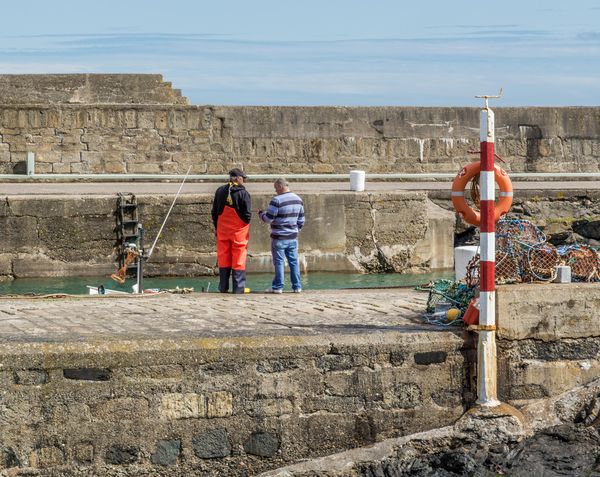
Oct 17, 2019 17:58:14 #
R.G. wrote:
If I intended to visit a place like that with hist... (show quote)
I like very much the "humility" and non-glamor of this shot.
Oct 18, 2019 10:51:44 #
R.G. wrote:
If I intended to visit a place like that with hist... (show quote)
It was interesting to view Hudson's collection. He did prioritize activity over scenic in his photography. I do not know whether he was doing something similar to what I do when I "harvest pixels" for later use. He may have been intrigued by the people and their activities, and he may have been preserving what he saw with his eyes for use in later paintings.
The work of "turf harvesters" is ancient and proscribed, much as lobster fishing is. I relate to and enjoy your image. I remember seeing others of this activity by Graham Smith that were interesting as well.
There is a fascination, for me, in how humans engage in such historically connected livelihoods, against the backdrop of a lovely landscape that is somehow almost incidental to the activity.
In this image, at the exact same location as Hudson's image, a first-time sternman performs a traditional task on the day before the season opens: she must launch a little wooden boat with the captain seated in it, and row him to his fishing boat moored in the harbor so they can prepare it for loading the traps. I watched, and recorded, her cheerful struggle and his passive observance of it, as well as her ultimate success. He is the harbormaster, descended from other harbormasters in a two-century lineage, and will lead the fleet to sea the next morning. She is new to this, proving herself able. It is a timeless scene.
Nov 28, 2019 07:35:09 #
Seeing that photo makes me think of this shot I took in 04. One of the artists in our group. I am looking forward to seeing some of your shots. It looks like the shed is unchanged if it is the same one in the photo. We were staying in the house on stilts to the right.
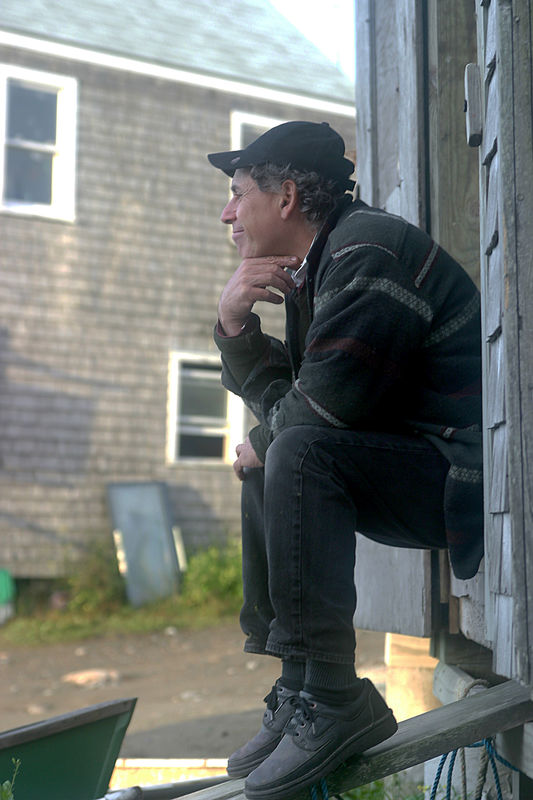
If you want to reply, then register here. Registration is free and your account is created instantly, so you can post right away.

